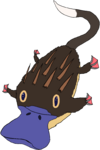Anatine Stakeshrew
| Anatine Stakeshrew | |
|---|---|
| Enemy | |
| Family | Stakeshrew |
The Anatine Stakeshrew is a species of aquatic, billed stakeshrew.
In fanon games
Below this point is where users place their version of the Anatine Stakeshrew.
In Pikmin: Interstellar Cryptid
|
This article or section presents information pertaining to Pikmin: Interstellar Cryptid, a fanon game created by CarrotStilts1. |
| |||
|---|---|---|---|

| |||
| Scientific name | Nymerocus palustorea | ||
| Family | Stakeshrew | ||
| Areas | Sweltering Field | ||
| Carry weight | 12 | ||
| Max. carriers | 20 | ||
| Seed worth | 10 | ||
| Attacks | Eats and stabs Pikmin | ||
The Anatine Stakeshrew is an aquatic enemy in Pikmin: Interstellar Cryptid. It resembles a fusion between two semiaquatic Australian mammals, the platypus and rakali. It has a long tail with a white tip, a round body with webbed feet, and nine spines that it can erect when on dry land. It's named such because its mouth is a blue-colored bill akin to a duck's. Living primarily in water, the Anatine Stakeshrew eats Blue Pikmin by trying to confuse and distract them, taking many intricate turns in the water to make it harder to discern what it's going to do. After a while, it will dive into the squad and grab the Blue Pikmin with its bill. If the squad leaves the water after getting its attention, it will chase them out, slowly waddling across the land in a desperate attempt to keep the chase on. During this time its spines will stand up and will stab Pikmin that are thrown onto it. Like the Foraging Stakeshrew, its tail can be tugged at this time, causing its spines to go flat until they let go.
Notes
Olimar's notes
- “Burrows by the water may contain these interesting animals. Related closely to the bugle stakeshrew, this rodent commonly dives in the water to snag subaquatic worms. These worms tend to live near the bases of aquatic grass, of which gets uprooted due to being in the way of the creature. This keeps their habitat from being congested by floating weeds. Curiously, it resembles certain species of monotreme, but it bears live young rather than laying eggs. It's likely another case of atavism underway, like the gatorgull.”
Louie's notes
- “The back meat of this organism can be thinly sliced into a healthier alternative to bacon. Try it hickory-smoked and it'll be good enough to eat in your next breakfast sandwich!”
Bentley's notes
- “If what Olimar says about it bearing live young is true, then why are there nectar eggs in its den? Maybe... this is the creature laying them! Though that does not explain why downy snagrets and other creatures that are not its young come out of the eggs. Hmmm...”
Eloise's notes
- “I'll admit, it looks like it will be very fun to ride it across the water like a horse. The only problem is that you will probably get very wet.”
